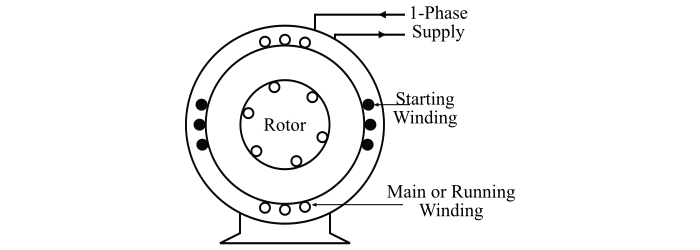
 Data Structure
Data Structure Networking
Networking RDBMS
RDBMS Operating System
Operating System Java
Java MS Excel
MS Excel iOS
iOS HTML
HTML CSS
CSS Android
Android Python
Python C Programming
C Programming C++
C++ C#
C# MongoDB
MongoDB MySQL
MySQL Javascript
Javascript PHP
PHPPhysics
Chemistry
Biology
Mathematics
English
Economics
Psychology
Social Studies
Fashion Studies
Legal Studies
- Selected Reading
- UPSC IAS Exams Notes
- Developer's Best Practices
- Questions and Answers
- Effective Resume Writing
- HR Interview Questions
- Computer Glossary
- Who is Who
Methods of Starting Single-phase Induction Motor
Why doesn't a Single-Phase Induction Motor Self-Start?
A single-phase induction motor consists of a squirrel cage rotor and a stator carrying a single-phase winding. But, a single-phase induction motor is not self-starting like a 3-phase induction motor since it requires some starting means.

When a single-phase supply is fed to the stator winding of the single-phase induction motor, it produces a magnetic field that pulsates in strength in a sinusoidal manner. The polarity of the magnetic field reverses after each half cycle but the magnetic field does not rotate in the space.
As a result, the alternating flux cannot produce rotation in a stationary squirrel cage rotor because the magnetic flux can be resolved into two components, each one rotates in the opposite directions at the same speed. Consequently, the net flux is zero, the induced current in the rotor bars is zero, and hence, the resulting torque on the rotor conductors is zero. Therefore, a 1-phase induction motor is not self-starting.
How to Make a Single-Phase Induction Motor Self-Starting?
Somehow, by producing a rotating stator magnetic field, the 1-phase induction motor can be made self-starting. This may be accomplished by converting a single supply into two-phase supply through the use of an additional winding or auxiliary winding.
As soon as the motor attains a sufficient speed, the starting means may be removed depending on the type of the motor. Hence, the single-phase induction motors are classified and named according to the method used to make them self-starting which are given as follows −
Split-phase Induction Motor – These motors are started by 2-phase motor action, which is achieved by the use of a starting or auxiliary winding.
Capacitor Motor – To start a capacitor motor, the two-phase motor action is achieved by the use of an auxiliary winding and a capacitor.
Shaded Pole Motor – This type of single-phase induction motor is started by the motion of magnetic field produced by the means of a shading coil around the portion of the pole structure.

